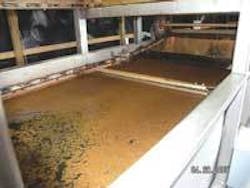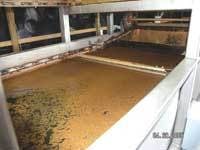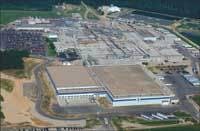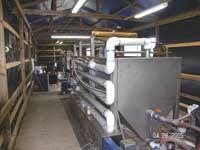Ohio Frozen Pizza Plant Initiative Enhances the Environment
• General Mills, GE Water & Process Technologies Find Alternative to Dissolved Air Flotation an Innovative Treatment Solution for Difficult Surface Water
During the summer of 2004, a challenge confronted Darin Davis, environmental manager of a General Mills facility in Wellston, OH, that’s the world’s largest producer of frozen pizzas. He needed to figure out a way to turn 90 million gallons of murky pond water into clear water with no more than 8 mg/L of suspended solids (TSS), the level required by the city’s publicly owned treatment works (POTW).
Draining the Swamp
“We needed to drain the entire 33-acre lagoon to make it possible to remove the sludge and land apply it,” Davis said. “We wanted to avoid trucking the water, however, because of the high cost and the potential environmental impact.”
Treating the lagoon water in the plant’s wastewater treatment system wasn’t an option. General Mills has a permit to discharge 700,000 gpd of treated wastewater into the creek, but nearly all of this capacity is utilized for the Wellston plant’s manufacturing operations. Two options remained: trucking the water away or discharging the water into the city’s POTW.
The POTW required that total suspended solids (TSS) not exceed 8 mg/L, and yet the TSS in the lagoon water typically measured in excess of 200 mg/L. The readings could fluctuate to double that value after spring runoff or during high-algae growth periods in the summer months.
Floating a Solution
Davis and his team approached GE Water & Process Technologies. “We had a history of working closely with GE at our wastewater plant and turned to them for assistance in solving this unusual surface water treatment challenge,” said Charles Camp, wastewater treatment plant supervisor at General Mills’ Wellston plant.
GE Water engineers proposed using Entrapped Air Flotation (EAF), a relatively new technology. It improves upon conventional Dissolved Air Flotation (DAF), a nearly-century-old wastewater treatment method widely used in a host of industrial applications primarily for liquids, solids, and oils separation. Conventional DAF uses pressurized gas to separate solids and oil from a water stream. EAF doesn’t rely on pressurized air, but rather air introduced under atmospheric conditions; and in conjunction with treatment chemistry, it allows precipitated contaminants to entrap the air bubble and facilitate separation from bulk water.
To optimize performance, the engineers conducted laboratory tests on water samples from the lagoon, using a variety of chemical formulations. As a result, the application of KlarAidTM IC1187, an inorganic coagulant, and PolyFlocTM AE1138, a high molecular weight flocculant, was recommended to enhance the process.
Working through Winter
“The EAF system proved to be an excellent solution,” said Camp. “Despite the highly variable and difficult-to-treat feedwater, we maintained an average flowrate of about 300,000 gallons per day, right through the cold winter, and we never exceeded the stringent TSS standards set by the POTW.”
One of the many challenges presented by this project was the lack of potable water at the site. Unfiltered water from the lagoon was employed as “drive water” in the EAF process. Despite concerns that the unfiltered water would be harmful to pumps and other components, the systems performed without failure.
Davis calculates that General Mills saved approximately $5 million by avoiding the expense of trucking the lagoon water. “We also saved another $150,000, because the water removal project was completed three months ahead of schedule,” Davis said. “It turned out that we needed this additional time for the sludge removal operation, because we ended up removing double the amount of sludge from the bottom of the lagoon compared to our original estimates.”
Conclusion
The project was a great success. The lagoon was drained, and all of the sludge used to enhance the soil of the surrounding farmland and former strip mines in the area.
GE Water & Process Technologies, a unit of General Electric, is based in Trevose, PA. Contact: Joe Ward, 614-203-8811, [email protected] or www.gewater.com



